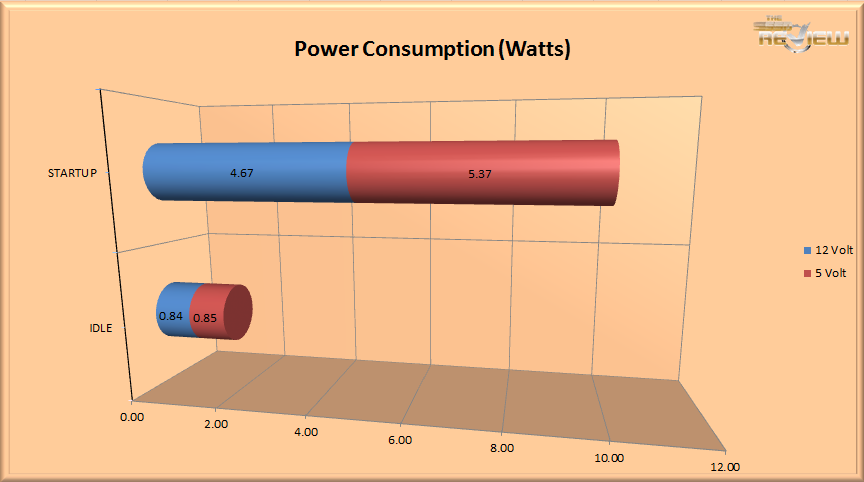POWER AND HEAT
Power consumption is always a ‘big deal’ in the server environment for several reasons. Providing power, and redundancy for that power, is a very expensive proposition and the highest ongoing expense for any enterprise application. Power consumption also equates to heat production, which in turn requires more power to effectively dissipate. A double edged sword, power and heat feed upon each other, generating a tremendous concern for system administrators.
SSDs in general fare well in this area, with some being more effective than others. Two key measurements are most often mentioned when discussing the power requirements of any Storage device, that being idle and start-up power consumption. Idle highlights the theoretical minimum power draw, while start-up represents the other end of that spectrum.
We measure the peak of the start-up power, even though this can be largely irrelevant of the long term power consumption of the device. While still a relevant metric, this harkens back to the HDD, where large start-up voltages can overpower Power Supply Units (PSU) when massive amounts of drives are brought online simultaneously.
Two hundred HDDs coming on at the same time can fry many a power supply, as the PSUs are ‘right sized’ for the loads that they are designed to handle during operation. As always, everything in the data center is tirelessly optimized, so drives have to be brought online in small groups so that the ‘perfectly-sized’ power supplies, which operate at high efficiency ratings, can handle them. SSDs use much lower thresholds, so the measurement isn’t nearly as relevant other than to highlight the theoretical maximums.
 The start-up power peaks right at 10 Watts, while the device sips a very miserly 1.69 Watts at idle!
The start-up power peaks right at 10 Watts, while the device sips a very miserly 1.69 Watts at idle!
We tested the rated 6.5 Watts claim for active power consumption through all of the profiles that we conducted during testing. These measurements were taken during high load under steady-state conditions at QD32. The device falls under the 6.5 Watts threshold in all tests, with the exception of 128K Sequential read, where it nudges over 7 Watts. This could be a measurement issue, as this is the only value significantly above the others. There is a +/- 10% variance in sampling.
 As heat is a huge concern in the data center, we have measured the heat output as well during our testing. Heat must be mitigated through various means of cooling inside the data center, so it can produce huge incremental costs. All heat measurements are done without any fan-driven air flow, so with any type of airflow the device will run much cooler than shown. The important measurement here is the amount of heat generated, and again the measurements were compiled during QD32 loadings in Steady State conditions. As we can see, the power usage and heat generation are very closely aligned!
As heat is a huge concern in the data center, we have measured the heat output as well during our testing. Heat must be mitigated through various means of cooling inside the data center, so it can produce huge incremental costs. All heat measurements are done without any fan-driven air flow, so with any type of airflow the device will run much cooler than shown. The important measurement here is the amount of heat generated, and again the measurements were compiled during QD32 loadings in Steady State conditions. As we can see, the power usage and heat generation are very closely aligned!
 Finally we come to the IOPS per Watt measurements. These measurements take the performance at QD32 compared to the amount of wattage consumed that we recorded. The SSD comes up well over the advertised spec of 13,800 IOPS per Watt that is advertised with 4k Random Read performance, coming in at 15,599 IOPS per our measurements. One can also note the healthy gain in IOPS/Watt when using the device over provisioned, gaining 682 IOPS/Watt.
Finally we come to the IOPS per Watt measurements. These measurements take the performance at QD32 compared to the amount of wattage consumed that we recorded. The SSD comes up well over the advertised spec of 13,800 IOPS per Watt that is advertised with 4k Random Read performance, coming in at 15,599 IOPS per our measurements. One can also note the healthy gain in IOPS/Watt when using the device over provisioned, gaining 682 IOPS/Watt.
 The SSD Review The Worlds Dedicated SSD Education and Review Resource |
The SSD Review The Worlds Dedicated SSD Education and Review Resource | 
Thanks for the detailed report. Can you compare/contrast this with the OWC enterprise drive, which is 1700 vs 6000 for the Toshiba. Is it worth 3 times the price? I do see the attention they paid to heat and don’t know if OWC has done the same homework, but the OWC drive does use an enterprise SandForce chip which should have the same features as the Marvell.
Awaiting arrival of the OWC SSD.
I guess the price difference is SLC vs eMLC, (correct me if I’m wrong) and their additional work on putting it together really well in terms of the heat dissipation. But in real terms I guess this comes down to longevity? It would be very interesting if you could do some applied but theoretical analysis of longevity comparisons. For example, if serving a database or web server with x writes and y reads per day how long would each last? I think the SLC is in the millions so that can be counted on for 5 yrs+ but the question is, with the features of the enterprise SF chip, what life can be expected there? The speed should be comparable, maybe with a slight bump for this drive in IOPS.